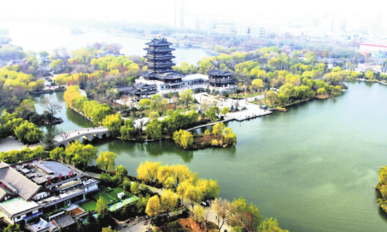
JU CHUANJIANG/CHINA DAILY
With a ring of ancient lakeside pavilions, residences and temples, the Daming Lake is Jinan's top tourist site.
Were it not for Daming Lake, Jinan's springwater would lose its charm.
One of the few springwater lakes in a Chinese city, the lake has been a nationally famous scenic spot since the Tang Dynasty (AD 618-907) for its picturesque view with a ring of lakeside ancient pavilions, residences and temples.
The area of Daming Lake has shrunk from 80 hectares 100 years ago to only 57 hectares today because of the reduction of springwater flow. The average water depth is about 2 meters and the deepest part of the lake is 4 meters.
Willows and lotuses, plants symbolic of the city, are the two most common plants around and in the lake. The fish, lotus roots and seeds produced in Daming Lake are regarded as God-given gifts by Jinan residents.
From a bird's-eye view over the city, the lake looks like a large emerald embedded in ancient square city encircled by a structured moat built in the 14th century.
The west gate is the main entrance of the lake park. A children's amusement park was built on the west bank of the lake in late 1970s. The amusement park, the largest of its kind in Jinan, had been a cherished memory for local children until the late 1990s when the Internet started spreading in China.
A small boulevard meanders along the lake bank. On the north of the children's amusement park is a little park and a patch of lawn, a site for the largest temple fair in Jinan during the Spring Festival each year. Visitors can enjoy the most authentic traditional local snacks, arts and opera performances at the fair.
There are three kinds of tourist boats on the lake, double-paddle boats for three to four people, pedal boats for two people and diesel-engine sightseeing ships for 50 people.
In the center of lake is the island called Lixia, which used to be the old name of Jinan. A little garden built in the Song Dynasty (960-1279) is well-preserved on the island and was a party site for ancient artists, poets and writers, who left plenty of calligraphy and painting works inscribed on stone tablets and wooden boards.
Beiji Temple, built in 1280 on a 7-meter-high stone stage on the north bank, is the place to worship the water god, a gaily painted mud statue resembling an emperor. It is also the best place to enjoy the lake view. In the main hall of the temple, there are valuable Song Dynasty frescoes with the complete story of how the water god grew up.
On the west bank is the Tiegong Temple for a national military hero of the Ming Dynasty (1368-1644).
Between the two temples is the Huibo Building, or wave-converging building, which is perched on a high solid stone base as well. There is a water canal, equipped with a water sluice, flowing through the bottom of the base. It is the only outlet for the springwater of the lake, called Xiaobei Gate, or small north gate. The canal connects the origin of the Xiaoqing River about 3 kilometers away in the north by an open watercourse of 5 meters in width.
The Xiaobei Gate is a crucial water-control project for old Jinan. It keeps springwater in the city during droughts and drains off the water in rainy seasons.
Standing on the Huibo Building, you can see two isolated cone-shaped hills called Queshan and Huashan several kilometers away on your left and right respectively. The Xiaoqing River flows between the two hills to the northeast like a jade-green silk belt.
The two hills, both 200 meters high and covered with thick vegetation, look like two guards clad in green defending the northern suburb of the city.
Two ancient gardens are located in the east and south of the lake. The one on the east was built in 1792 and is of South China style. The southern one was built in 1909, mixing some Western architectural elements in its Chinese style, and was used as part of the provincial library until the "cultural revolution" (1966-76).
The ancient wood-brick buildings surrounding the lake, built from the Yuan Dynasty (1271-1368) to the Qing Dynasty (1644-1911), integrate well with the natural landscape. The Thousand Buddha Hill embracing the south of Jinan is like a screen shaping the city's skyline with greenish curves, which is reflected in the mirror-like lake surface on sunny days.
Many Jinan people play beside the lake during their childhood days, go on boat rides with their dates when they grow up and stroll around the lake after retirement. Similar memories hold the communities together. The lake makes Jinan a big family, as many locals would tell you.
We recommend:
